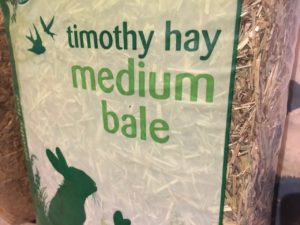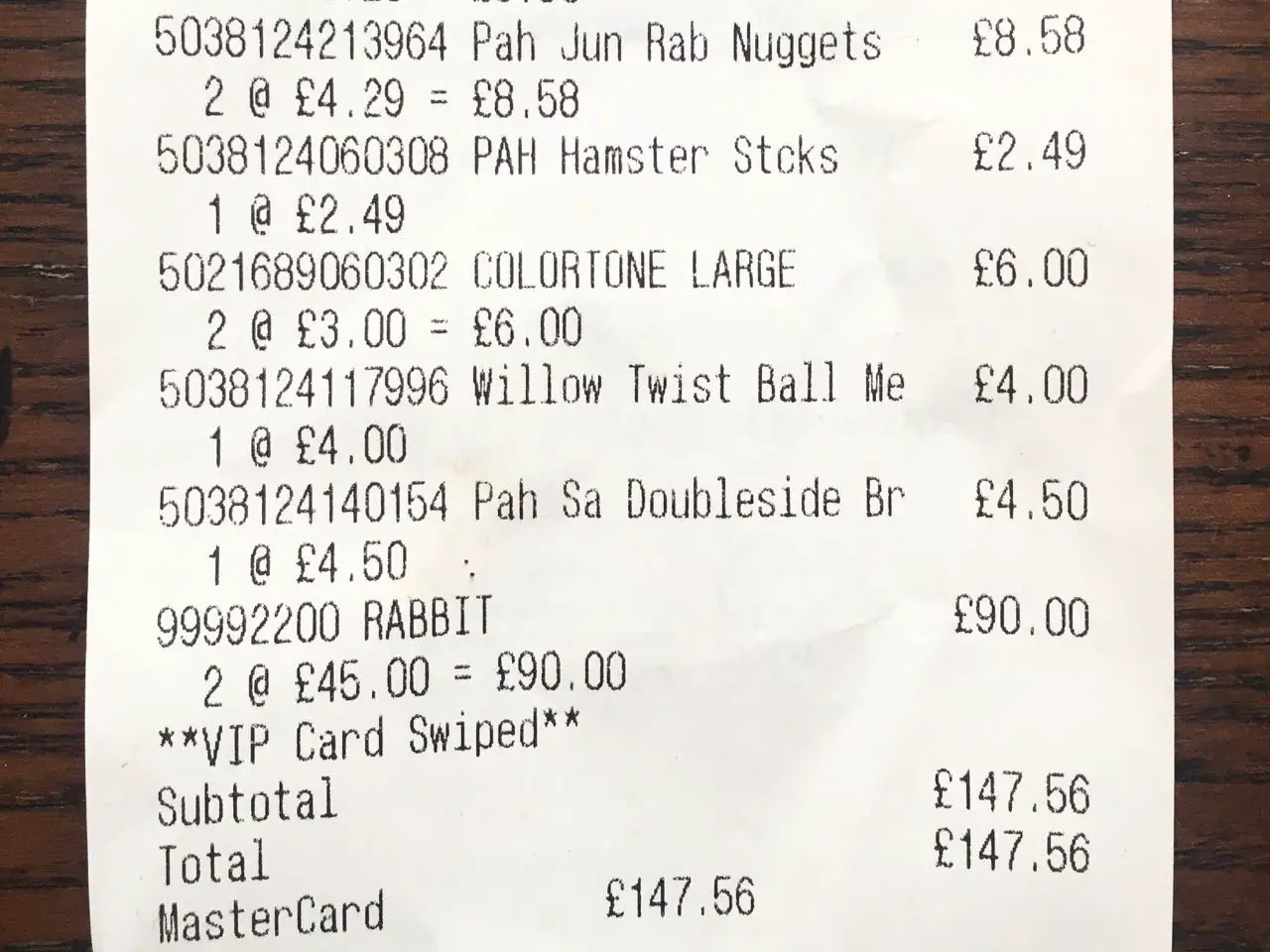When we first bought Fish and Chips, our much loved bunnies, we were entirely new to the world of pets. We had never owned any type of pet before. I literally had no idea how much it would cost to buy a rabbit or to keep a rabbit.
Perhaps you’re in the same position. You’re thinking about buying a pet rabbit, and wondering how much it is going to set you back, both upfront and year to year.
The costs can add up (and remember that pet rabbits can live up to ten years – this is a long term commitment).
This is our experience of buying two pet rabbits. I hope you find it useful, and enables you to make a more informed decision.
How much does it cost to buy and keep a pet rabbit?
It costs between £150-500 ($200-650) to buy a pet rabbit, rabbit hutch (cage) and equipment. The main difference in cost will be the quality of hutch you get – hutches designed to last outdoors cost more. It costs about £550 (about $700) a year to keep a rabbit, including insurance and vaccinations, hay and bedding. Treats and toys are additional costs to these.
| Cost (£) | Notes | |
|---|---|---|
| One-off costs | ||
| Rabbit | £0-50 | Ideally you buy two rabbits or more – they are sociable animals who need company |
| Spaying/neutering | £70-80 | Spaying/neutering leads to healthier, longer-lived, calmer rabbits. Remember to double this cost if you buy two rabbits. |
| Hutch & run | £50-350 | Outside hutches need to be large, secure and with a secure run. You also need a cover for winter. Inside hutches still need to be suitable. |
| Litter tray | £10 | Simple plastic. |
| Water bowl | £3 | Heavy and shallow so doesn’t get knocked over. |
| Feeding bowl | £3 | Same as water bowl. |
| Hair brush | £4 | Regular grooming helps rabbits. |
| Hay manger | £10 | Hay is the main food for rabbits. |
| Total | £150 to £510 | |
| Running costs per year | Remember to double up if you have two rabbits | |
| Vaccines/health check ups | £96 | Your rabbit will need vaccinating every year (included as part of health plan). |
| Insurance | £120-180 | Pet insurance can save you a lot of money if your rabbit needs any medical care. |
| Bedding | £216 | Straw and bedding needs replacing weekly. |
| Hay & pellets | £124 | A rabbit’s main diet should be hay. |
| Toys and treats | £0-£200 | Rabbits get bored easily. Toys and treats keep them entertained and happier. |
| Total | £556 to 816 |
How much does a rabbit cost?
A rabbit from a pet store will cost about £45 (or $20-40). You can buy a rescue rabbit for less than this.
At first, we thought we were going to be buying a pet rabbit. We were wrong. We ended up buying two rabbits.
Why? Because rabbits are sociable creatures. They enjoy company. Either you need to guarantee a lot of human interaction every day and throughout the day, or they need a bunny companion (more info here).
The good news is that rabbits are relatively cheap to buy. You may even be able to adopt a rabbit from a shelter for free.
The less good news is that, ironically, rabbits are not the main cost of buying rabbits!

We bought Fish and Chips from a pet store.
Some organisations strongly suggest you never do this and only adopt rabbits from shelters. At the time, we didn’t know much about rabbits at all.
All I can say is that the pet store we used (Pets At Home) was professional, cared for the rabbits, refused to sell them at inappropriate times (weather too cold; rabbits too young), provided excellent information on caring for rabbits, ensured we had suitable facilities at home before selling the rabbits, and also supports the adoption of rabbits.
They also refuse to sell rabbits over the Easter weekend, to ensure that people aren’t buying bunnies on impulse. Many of the staff owned rabbits themselves, and all seemed passionate about the animals.
We paid £45 for each rabbit. However, this included RHD1 vaccination, which on its own can cost £40.
Rabbits available for adoption were generally cheaper, and some of them were already vaccinated and neutered or spayed.
In the USA, typical prices are around $20-40. Again, this can be cheaper if you are buying from a shelter.
Our rabbits, cute as they are, have no pedigree. If you are buying a rare breed, the price is likely to be higher (maybe even hundreds of dollars).
We paid £45 per rabbit.
Medical matters and insurance
Your rabbit(s) will need regular trips to the vet for vaccinations and other costs. These are for routine issues; this is separate from going to the vet for any emergencies or illnesses that your bunny may have.
Your rabbit will need two vaccinations each year (combined RHD1/myxomatosis, and RHD2) and protection against flystrike. You can pay separately for these, but most vet practices offer a package combining them all, which ends up cheaper.
Vets4Pets (which is associated with Pets At Home) charges £8 per month (£96 annually – 2022 price), and also included a consultation as well.
If your rabbit isn’t already spayed/neutered, you need to include this cost (it is highly recommended by practically all organisations). It typically costs a little more to spay a female than it does to castrate a male. Find out more about the whole process in our article.
And then there’s insurance. This typically costs £10-15 per month. The usual price comparison websites don’t include pet rabbit insurance (they only offer one choice). I researched the area – you can see my comparison between the main five UK providers here.
We paid £80 per rabbit for spaying.
We pay £96 every year per rabbit for a care plan for vaccinations.
We pay £130.56 every year per rabbit for pet insurance.
Hutch, run and cover
You can spend a little or a lot on a hutch. Partly it is going to depend whether your rabbit(s) is going to live indoors or outside. In the UK, there is pretty much a 50:50 split.
Our rabbits live outside, so we needed a hutch that was a decent size; that would keep them safe from foxes or cats; and that last in Manchester’s wet climate. Indoor hutches can be cheaper (though still need to be large).
We did some digging around, and settled on the Large Coach House hutch, with a run and a cover for winter. It arrived flat-packed, and we assembled it ourselves. You can read our user review of the Large Coach House rabbit hutch here.
You can expect a good quality rabbit hutch to last three years if kept outside. Beyond this, you might need to start making more and more repairs as the weather and the bunnies cause wear and tear. In particular, bunnies can chew wood, and can nibble away at struts and wooden supports over time.
We paid £312 for the hutch, the run and the cover, including delivery.
Equipment
Your bunny will need some stuff besides the hutch itself. This is what we ended up buying:
- Litter tray – we chose a large plastic one £12
- Water bowl (heavy so can’t be knocked over) £3.25
- Feeding bowl (to put pellets in) – ended up same as water bowl £3.25
- Small double sided brush £4.50
- Dustpan and brush (to help clean out the hutch – we didn’t fancy using our normal one) £2
- Hay manger to hang on side of hutch £10.40
In total, we paid £35.40 on equipment
Bedding and Litter
The hutch needs cleaning out each week. We then line the bottom of the hutch with newspaper, and then woodshavings (with dust extracted) on top. In the bedding area, we use straw (again, make sure that it is dust extracted).
A large (10kg, 22lb) bag of woodshavings costs about £10.
A large bag of straw costs about £4.
You will need about one bag each month.
We also use litter in the litter tray. A 20l bag sets us back about £12. You’ll need about 4 bags a year.
We pay £216 a year on bedding and litter.
Food

The main diet of rabbits is hay, and we always try to buy Timothy hay (read here to find out why). In England you can buy Timothy hay for about £4 for 1kg of hay (which goes further than you’d think). I haven’t kept track, but about half a bag every week per rabbit seems about right. We buy ours from pet shops (some supermarkets also stock hay), but you can also order from Amazon UK or Amazon US.
If you are near a farm (one of our friends is), you might be able to get access to hay a lot cheaper than this.
The bad news if you’re American is that getting Timothy hay seems to be a bit more expensive than in England. It’s worth buying a bigger bag to save money.
Rabbits also have pellets of dried hay (no more than half an eggcup per day per rabbit). The pellets cost about £10 for a 2kg (4.4lb) bag. You probably won’t need much more than a few bags a year. Again, you can get these from pet stores, or direct from Amazon UK.
On top of that, we also regularly buy herbs and other greens when doing our supermarket shop (but not chives! See why not here). I haven’t included this cost.
We pay £124 per rabbit every year for hay and pellets.
Toys and treats
The good news: toys and treats tend to be inexpensive.
The bad news: buying them becomes a little addictive…
And most toys are something that your bunnies love to chew on. This means that, after a day or so, they will have been destroyed by your rabbit’s gnawing and chewing. So you buy another one…
As an example, we found that our bunnies really enjoyed chewing and messing around with small hay boxes. We have bought three in the month.
You can read here about some of our favourite treats and toys for our bunnies in our rundown of ten of the best (and they’re all pretty cheap).
We pay about £180 every year for toys and treats.
Other costs
We have had other costs, but these depend on our particular circumstances. For example, we needed to improve the fencing in part of our garden to make sure that the bunnies couldn’t escape. This took a couple of days work plus materials from B&Q (similar to Home Depot).
Conclusion
Thinking about buying a pet rabbit? It’s always worth having some idea up front about what you are committing yourself to.
We love our rabbits, Fish and Chips, and are delighted we took the plunge.
Our experience is here to help you make sure you can commit to affording and looking after your rabbit(s) not just today, but in the years to come.
And rabbits make great pets (you can read our 7 reasons why they’re better pets than dogs here).


